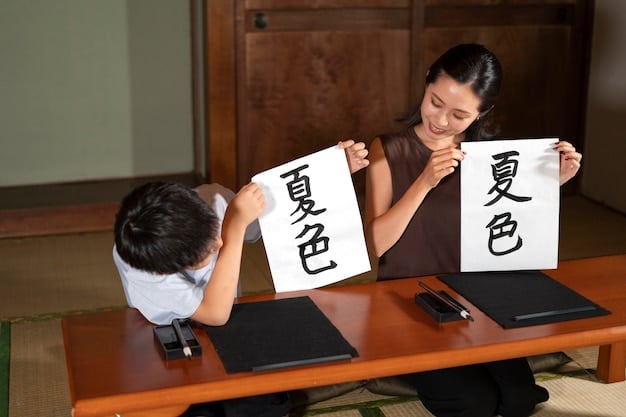K-Drama Subtitles: How Accurate Translations Impact US Viewership

K-Drama subtitles significantly influence US viewership by bridging cultural and linguistic gaps, affecting audience engagement, understanding, and the overall appreciation of Korean television content.
The rising popularity of K-dramas in the United States has brought the importance of accurate and culturally sensitive subtitles to the forefront. K-Drama Subtitles: The Impact of Accurate Translations on US Viewership can’t be overstated as they directly affect how American audiences perceive and enjoy these shows.
Why Accurate Subtitles Matter for US K-Drama Fans
For American viewers, subtitles are the gateway to enjoying K-dramas. Accurate subtitles go beyond simple word-for-word translation; they capture the nuances of Korean culture, humor, and emotions, ensuring that the viewing experience is both engaging and authentic.
Cultural Nuances
Korean culture is rich with unique expressions and social cues that may not have direct equivalents in English. Subtitles must convey these nuances to help viewers understand the context and intent behind the dialogue.
Emotional Resonance
Emotions are a universal language, but the way they are expressed can vary significantly between cultures. Subtitles need to accurately portray the emotional tone of the characters, preserving the intended impact of the scene.

When subtitles fail to capture these elements, viewers may miss out on crucial aspects of the story, leading to misunderstandings or a diminished appreciation of the K-drama. Ensuring accuracy is vital for fostering a genuine connection between the show and its audience.
Here are key aspects of why accurate subtitles are crucial:
- Enhances understanding of the plot and character motivations.
- Preserves the cultural context and humor intended by the creators.
- Avoids misinterpretations that can detract from the viewing experience.
- Builds a stronger connection between the K-drama and American viewers.
Ultimately, accurate subtitles bridge the gap between cultures, allowing US viewers to fully immerse themselves in the world of K-dramas.
The Challenges of Translating K-Dramas
Translating K-dramas presents a unique set of challenges. Beyond linguistic differences, translators must navigate cultural subtleties, idiomatic expressions, and varying registers of speech to provide an accurate and compelling viewing experience for American audiences.
Linguistic Differences
Korean and English have vastly different grammatical structures, which can make direct translations awkward and confusing. Translators need to adapt the dialogue to fit the natural flow of English while preserving the original meaning.
Idiomatic Expressions
Korean idioms and proverbs often have no direct equivalent in English. Translators must find creative ways to convey the intended meaning, often substituting with similar expressions or providing explanatory context.
Register of Speech
Korean language has a complex system of honorifics, which vary depending on the speaker’s relationship and social status. Translators need to reflect these nuances in English, using appropriate levels of formality and respect.
Here are some additional considerations:
- Time constraints and tight deadlines can impact the quality of translations.
- Balancing accuracy with readability to ensure the subtitles are easy to follow.
- Maintaining consistency in terminology and character voices throughout the series.
Addressing these challenges requires skilled and experienced translators who are not only fluent in both languages but also deeply familiar with Korean culture.
The Impact of Poor Subtitles on US Viewership
Poorly translated subtitles can have a significant negative impact on the viewership and reception of K-dramas in the US. Inaccurate or confusing subtitles can lead to frustration, disengagement, and ultimately, a loss of interest in the show.

Misunderstandings and Confusion
Inaccurate subtitles can lead to misunderstandings of the plot, character motivations, and cultural references. This confusion can detract from the viewing experience and make it difficult for viewers to follow the story.
Reduced Emotional Connection
If subtitles fail to accurately convey the emotional tone of the dialogue, viewers may not connect with the characters or feel the intended impact of the scene. This can result in a less immersive and enjoyable viewing experience.
Negative Word-of-Mouth
Viewers are quick to share their experiences with others, and negative feedback about poor subtitles can spread rapidly online. This can discourage potential viewers from giving the K-drama a chance, ultimately impacting its success in the US market.
Here are important factors to consider:
- Increased churn rate as viewers abandon shows with poor subtitles.
- Damage to the reputation of the K-drama and its creators.
- Loss of potential revenue for streaming platforms and distributors.
Investing in high-quality subtitles is essential for ensuring that K-dramas are well-received and enjoyed by American audiences.
The Role of Streaming Platforms in Subtitle Quality
Streaming platforms play a crucial role in ensuring the quality of K-drama subtitles. As the primary distributors of these shows in the US, they have a responsibility to invest in accurate and culturally sensitive translations.
Quality Control Measures
Many streaming platforms have implemented quality control measures to ensure that subtitles meet certain standards. These measures may include using experienced translators, conducting thorough reviews, and incorporating feedback from viewers.
Community Contributions
Some platforms also allow community members to contribute to the subtitling process. While this can be a valuable resource, it’s important to have proper moderation and oversight to ensure accuracy and consistency.
Investment in Technology
Advancements in translation technology, such as machine learning and AI, are also playing a role in improving subtitle quality. However, these technologies should be used as tools to assist human translators, not as replacements for them.
Several aspects should be enhanced:
- Increased transparency about the subtitling process.
- Greater collaboration between platforms, translators, and cultural experts.
- Continued investment in technology and quality control measures.
By prioritizing subtitle quality, streaming platforms can enhance the viewing experience for American audiences and help K-dramas reach their full potential in the US market.
Finding High-Quality K-Drama Subtitles
For US viewers looking to enjoy K-dramas with accurate subtitles, there are several strategies they can employ to ensure a positive viewing experience. Choosing reputable streaming platforms, seeking out community-driven resources, and understanding subtitle terminology can make a significant difference.
Reputable Streaming Platforms
Opting for well-known streaming platforms known for their commitment to quality subtitles is a good starting point. These platforms often invest more in professional translation services and quality control measures, which leads to more reliable and accurate subtitles.
Community-Driven Resources
Exploring community-driven resources such as fan forums and review sites can provide valuable insights into the quality of subtitles for specific K-dramas. User reviews and ratings can help identify shows with well-regarded subtitles.
Subtitle Terminology
Familiarizing yourself with subtitle terminology, such as “hard subs” and “soft subs,” can help you make informed choices about how you watch K-dramas. Understanding the difference between these types of subtitles can impact your viewing experience.
Here are some more helpful tips:
- Read reviews and ratings of K-dramas to check subtitle quality.
- Join online communities to get recommendations on where to watch K-dramas with great subtitles.
- Look for subtitles that are clear, concise, and easy to read.
Taking these steps can help US viewers find and enjoy K-dramas with subtitles that enhance their viewing experience.
The Future of K-Drama Subtitles in the US Market
The future of K-drama subtitles in the US market looks promising, with ongoing advancements in technology, increasing awareness of cultural sensitivity, and a growing demand for high-quality translations. As the popularity of K-dramas continues to rise, the importance of accurate and engaging subtitles will only increase.
Advancements in Technology
Technological advancements such as machine learning and AI translation tools are revolutionizing the subtitling process. These technologies can assist human translators in producing faster and more accurate subtitles, helping to meet the growing demand for K-dramas in the US.
Cultural Sensitivity
There is a growing awareness of the importance of cultural sensitivity in subtitling. Translators are becoming more attuned to the nuances of Korean culture and are working to ensure that subtitles accurately convey cultural context without misrepresenting or offending viewers.
Demand for Quality
The increasing demand for high-quality subtitles is driving streaming platforms and distributors to invest more in professional translation services. As viewers become more discerning, they are demanding subtitles that are not only accurate but also well-written and engaging.
Here are some other major trends:
- More collaboration between translators and cultural experts to improve accuracy.
- Greater emphasis on localization to tailor subtitles to specific audiences.
- Continued innovation in translation technology to enhance efficiency and accuracy.
These trends suggest a bright future for K-drama subtitles in the US market, with better quality translations enhancing the viewing experience for American audiences.
| Key Point | Brief Description |
|---|---|
| 👍 Accurate Subtitles | Enhance understanding and emotional connection. |
| 🌍 Cultural Nuances | Capture cultural context for US viewers. |
| 📉 Poor Translations | Lead to confusion and reduced viewership. |
| 🎬 Streaming Platforms | Play a vital role in ensuring subtitle quality. |
Frequently Asked Questions (FAQs)
▼
Accurate subtitles are essential because they allow viewers to fully understand and appreciate the cultural context, humor, and emotional depth of K-dramas, leading to a more immersive and enjoyable experience.
▼
Challenges include linguistic differences, idiomatic expressions, and cultural nuances that don’t have direct equivalents in English, requiring translators to find creative and accurate ways to convey the original meaning.
▼
Poor subtitles can lead to misunderstandings, reduced emotional connection, and negative word-of-mouth, which can discourage potential viewers and ultimately decrease the viewership and popularity of K-dramas.
▼
Streaming platforms are responsible for ensuring subtitle quality through quality control measures, community contributions (with moderation), and investment in translation technology to deliver accurate and engaging subtitles.
▼
Viewers can find high-quality subtitles by choosing reputable streaming platforms, seeking community-driven resources for recommendations, and understanding subtitle terminology to make informed viewing choices.
Conclusion
In conclusion, the impact of accurate translations on US viewership of K-dramas is undeniable. Subtitles serve as a bridge between cultures, and prioritizing their quality is essential for fostering a deeper appreciation and enjoyment of Korean television content among American audiences. As technology advances and cultural sensitivity grows, the future of K-drama subtitles in the US market looks promising, with the potential to enhance the viewing experience for all.





